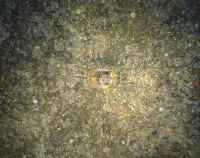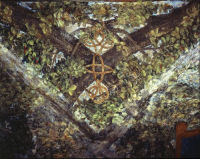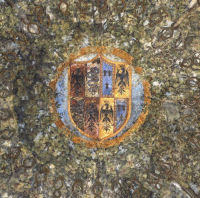The Natural World Click on the thumbnails to explore the trail
Read more about this trail (expand)
Leonardo’s endless curiosity regarding the form and function of all natural phenomena is attested to in his drawings, manuscripts and paintings. As nature could only be understood by direct “experience” or engagement with real life models, man, plants, animals, and the world that they inhabited became the subject of intense scrutiny in the quest for understanding of all natural things.

- Enlarge
- Zoom & explore
- © Castello Sforzesco, Milan

- Enlarge
- Zoom & explore
- © Castello Sforzesco, Milan

- Enlarge
- Zoom & explore
- © Castello Sforzesco, Milan
Sala delle Asse c1498-99
For Leonardo, trees more than any other natural phenomena illustrate the principles governing life and growth in nature.
In the Sala delle Asse, or “chamber of boards”, the artist devised an imaginative painted scheme based on his studies of nature, which illustrated the power and status of his patron. This consisted of great trees with their branches rising up and across the ceiling to intertwine to form a sort of fictive pergola. The branches are interlaced with a gold rope and form geometric arabesques and patterns around the coat of arms of Ludovico Sforza. The gold interlace symbolises his wife, Beatrice d’Este.
It also embraces inscriptions referring to his defeat of the French, his rise to become Duke of Milan, and the wedding of his niece Bianca Maria to the Emperor Maximilian. The trees are mulberries, a pun in Italian on Ludovico’s nickname, “il Moro”, as the Italian word for mulberry is gelsomoro.
Leonardo’s “forest room” is not only a novel expression of Ludovico’s strength and wisdom as a military ruler, but also the artist’s powers of artistic invention and a testament to his knowledge of nature.
In Leonardo's words
The gaps made by air within the bodies of trees and the gaps made by trees within the air will not be shown to the eye over a long distance, because where the whole is perceived with effort, the parts are distinguished with difficulty. Rather a confused mixture is made, which mostly takes on the appearance of the part having the greater bulk.
Little remains today of the Leonardo’s decorative paintings in a suite of rooms in the north-east tower of the Castello Sforzesco. Although nothing survives of the paintings of the Sala Negra, in the Sala delle Asse (“Room of the wooden panels”) fragments of trees are visibly portrayed on the upper sections of the lateral walls. Leonardo worked on this mural with his assistants.
The branches of the trees are interwoven with golden braids to form a dense canopy that stretches across the ceiling and around the arms of Ludovico Sforza and Beatrice d’Este positioned in the centre. Other tablets on the ceiling with inscriptions refer to the marriage of Ludovico’s niece to the Emperor Maximilian in 1493, and to the Sforza’s claim to the Dukedom of Milan after the death of Filippo Maria Visconti, as proclaimed by Maximilian in 1495. A third tablet proclaims Ludovico’s victory over the French at the Battle of Fornovo, and his journey to Germany to cement an anti-French alliance with Maximilian in 1496.
The trees appear to be mulberry trees and as such are a reference to Ludovico Sforza, who was known as “il Moro”. Surviving documents thought to relate to the decoration of the rooms imply a completion date of 1498 for the work.
- Medium Tempera on plaster
- Location Castello Sforzesco










